Erstellt am: 29. 8. 2012 - 21:00 Uhr
Journey to the Centre of the Fringe
Usually it works: I go to a place without having done any journalistic research, ask the first person who looks informed to inform me about it, take the best of their knowledge, and thereafter pretend to be an expert on the subject. Why, I've even gone into interviews with famous people, and demanded during the interview that they tell me who they are and what the interview should be all about! But at the Fringe Festival in Edinburgh I merely floundered about and drowned in the sheer size of the festival.

Johnny Bliss, 2012
2600+ Shows.
* - meaning: 'at the same time', just FYI
Bist du deppat. There is the main guide, the "Fringe" Bible, measuring a total of 376 pages of listings for over 260 venues. The Fringe alone incorporates literally dozens of smaller Fringe-connected festivals, and is itself only one of several major summer festivals taking place in the city annually; other festivals going on concurrently* include the Edinburgh International Festival (comprised of mainly ultra-famous, "above-ground" dance, opera, theatre, and classical performances - for its historical connection to the Fringe, see below), the Edinburgh International Book Festival, and the Edinburgh Art Festival.
Even these are sandwiched on either side by the likes of the Edinburgh International Film Festival (in June), the Edinburgh Jazz & Blues Festival (in July), and the Edinburgh Mela (end of August till early September).
If you factor in that all of this is taking place in a small city with a resident population only a little bit larger than that of Graz, your head could be forgiven for exploding.
But okay. Back to the Fringe Festival; that is, after all, the festival I came to Edinburgh to cover. The other ones I did not previously research at all (translation: I did not even know they existed), and certainly did not have press accreditation for (translation: I could not visit them for free).
*(1) - actually, my first question was "Who are you and what should this interview be about?" but I thought I would omit that question, so as to make me look more professional.
*(2) - Definition courtesy of the Urban Dictionary.
"So what the heck is a Fringe then??"
... is the first question I asked Neil McKinnon, the Fringe Festival's Head of External Affairs*(1). Naturally, I did not mean the word Fringe [which, in the context of one's head, can mean the "goofy short bit of hair that comes down to your eyebrows"*(2), but in normal English usage generally refers to either a borderline or a boundary], but rather the festival. Obviously.
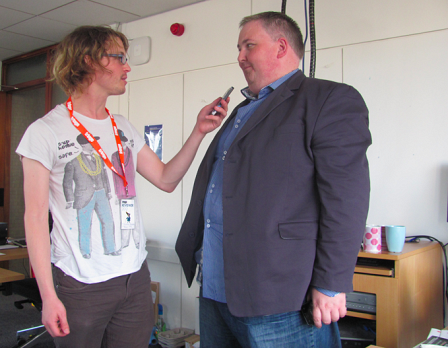
Johnny Bliss, 2012
* - That would be the Edinburgh International Festival referenced five paragraphs ago, BTW.
"In 1947, in post-war Europe, they decided to have an International arts festival in Edinburgh* to raise people's spirits, and to distract them from the austerity which was pervasive across the whole continent. However, they failed to invite eight particular theatre companies to take part in this festival. But those theatre companies thought that they would come to Edinburgh anyway, because there would be an audience for their shows here, and thus the Fringe was born.
"The Fringe ethos of people coming, whether they have an invitation or not, is still the dominant theme of the Fringe today.
"There are over ten different art forms reflected at the Fringe: comedy, theatre, musicals and opera, street events, children's shows, [and more]."
Looking at this giant book you have here (at this point, I was rifling through the 376 page so-called Fringe Bible), it seems like a majority of the arts represented here are comedy.
"Well, comedy makes up about 35% of the program, so it's not even really the majority. And although the Fringe has grown over the last few years, the proportions of different art forms have remained pretty constant over that time. So I don't think there's any danger of any one art form taking over anything else."
How many comedians does it take to screw in a lightbulb?
"How many?"
Generally about one comedian.
"That's terrible!"
Moving on... There is a massive volume of paper being produced in the form of flyers, posters, magazines and free papers promoting the various shows. It seems to me that the same amount of paper could very easily have otherwise been used, for example, to be a forest.
"Well, it's very important to the audience that we're able to provide them with information about the different shows, in order to have them make selections about what they're going to see, but we do care passionately about our sustainability record, in terms of energy and in terms of paper. We are making significant progress every year!"
But is it also possibly too much art? I've spent hours looking at this giant book today, and as a result I've not actually seen anything.
"Yes, I'm sure it can be over-whelming."
And would you have any informal tips for a person like me trying to find his way to the metaphorical gold in the river?
"Well, the Fringe Society isn't allowed to make recommendations, so I'm afraid you're on your own."
RE: "Not even really a majority"
* - Not saying that that's what I did. Of course not.
Only 35% of the program it may have been, but if you were to merely wander blindly from venue to venue without any sort of plan*, you would find comedy (at least in the "Free Fringe" part of the festival), definitely the strongest and most prevalent of the represented art forms, with cabaret as a very distant second.
* - Why am I telling you these names out of context? Just in case you ever find yourself at the Edinburgh Fringe, feeling as overwhelmed as I sometimes did, it can be reassuring to have some familiar names to reach for. I can vouch for most of the things I name here.
I'm not complaining, mind you. Even in the comedy world, there is a lot of room for variation, so sometimes you would watch an Improvised comedy troupe, (I found Battle Acts at the Free Sisters to be particularly good*) and other times stand up comedy mixed with satirical music.
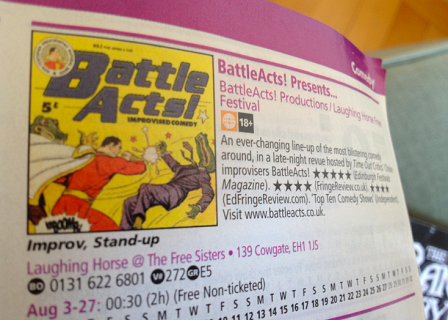
Johnny Bliss, 2012
It could be a very mixed bag. Some shows were amazing, others were clearly those of amateurs still finding their craft.
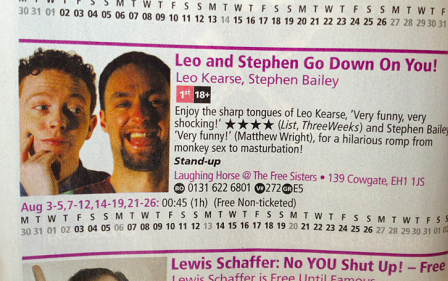
Johnny Bliss, 2012
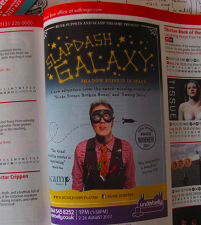
Johnny Bliss, 2012
But if Comedy was in the minority at the Fringe, you can imagine that Austrian comedy was even more scarce. How very scarce? Well, there was exactly one Austrian performing at the festival. One singular Austrian.
Naturally, I went to see her show.
An Austrian and a Person From Slough.
I was terrified, absolutely terrified that Alice Frick's show would suck.
What would I write here? How could I cast a positive light on a miserable comedy performance without offending my adopted country's delicate sensibilities and getting deported back to Canada?
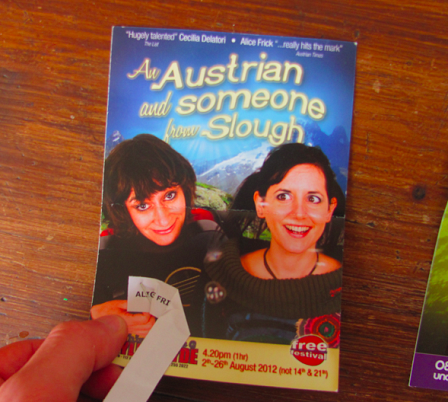
Johnny Bliss, 2012
Fortunately, this was a dilemma I would be able to avoid altogether. Both the Austrian in question (Alice Frick) and her British sidekick/landlady (Cecilia Delatori) were funny, smooth, and absolutely original.
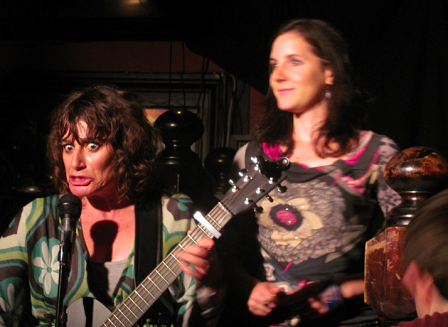
Johnny Bliss, 2012
The concept of the show, to paraphrase, is that Cecilia Delatori (the person from Slough) is Alice's landlord, a very "ordnungs-besessene Frau" (to quote Alice), and Alice gets a 20-minute slot to tell some jokes if she keeps the apartment clean. Cecilia tells some jokes, plays some self-depricating songs about love and life, and Alice has her own separate show in the middle. Toward the end they do a song together in German.
Alice's stand up routine itself?
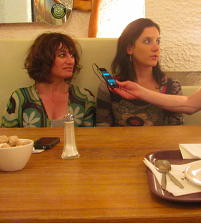
Johnny Bliss, 2012
Obviously, being in Edinburgh it is in English, and consists of making fun of Austrian stereotypes mixed with outlandish (but apparently true) stories of Alice getting arrested for drunk driving in Los Angeles, contemplating a career in porn, and attending AA meetings without knowing what the "AA" stood for.
As much as I would love to include a complete transcript of the interview here, that would take me years to do with my German and I almost certainly would do it amusingly badly. So what I will provide instead is some actual audio from our interview to listen to. Cool? Cool.
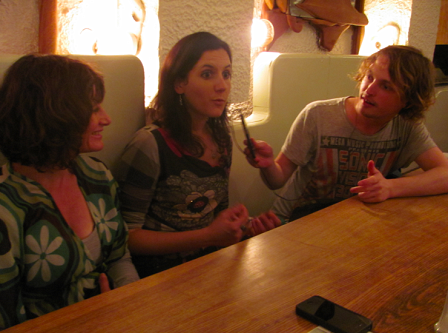
Johnny Bliss, 2012
When all else fails, go Canadian.
Having exhausted my supply of Austrian performers to cover at the festival, and having not even found a single Icelander (it broke my heart), I moved on to my other home country, Canada, and found a rather large supply of shows to choose from.
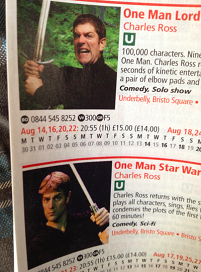
Johnny Bliss, 2012
The highlight of Canadian shows for me was, and will remain, the double feature of Prince George native Charles Ross' "One Man Lord of the Rings" (in which he plays every single character in the LotR film trilogy) and "One Man Star Wars" (ditto, with the original Star Wars trilogy). Along with a fantastic interview with Charles, these two shows were funny and original enough to deserve their own radio feature and web story.
So stay tuned, I'll try to provide that for you over the next couple of weeks. For now, here is a picture of a couple of Scottish cows in the countryside some forty kilometres from Edinburgh.
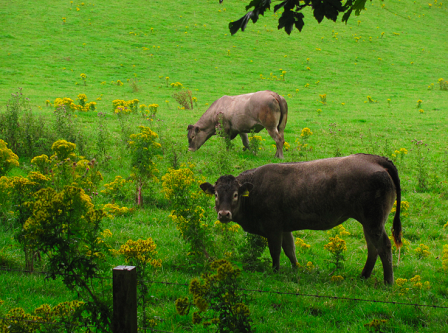
Johnny Bliss, 2012
What else was good? Well, there was the Canadian slam poet Shane Koyczan, who hails from my old stomping grounds of British Columbia, and allegedly was the winner of the Canadian Spoken Word Olympics.
I have never heard of those before, but I can imagine it is true. His work is very much on the themes of handling personal loss, and being treated cruelly as an outsider for one reason or another.
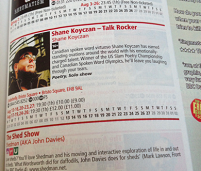
Johnny Bliss, 2012
Although there were very funny moments as well, one is left with the lingering impressions of rage against cruelty and injustice, sadness and regret, love, and ultimately forgiveness; if you've ever been bullied or given the feeling of being an Outsider, you will find it a very powerful and evocative show, and all the more so for it being in the proximity of so much fluffy and comparatively superficial stand-up comedy.
Both mediums involve a performer standing in front of a microphone and talking about their life, but Mr. Koyczan's heart-wrenching and intimate slam poetry demands to be noticed and acknowledged: it is indeed something very different from just about everything else on show, and this makes it all the more powerful. Highly recommended.
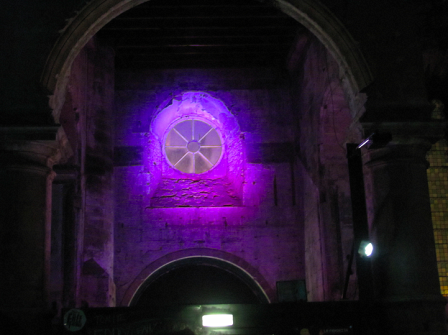
Johnny Bliss, 2012
On a final note, I witnessed a couple cabaret shows as part of the "Free Fringe", and feel that they deserve some sort of acknowledgement. The first one was (remarkably) in an old and majestic cathedral called the Tron Kirk (church), which had been converted into a really awesome venue. It still had stain glass windows with churchy art and sculptures everywhere - a very remarkable place to see a show, and fairly subversive as well (some would say "sacrilegious"), when you consider that it was burlesque.
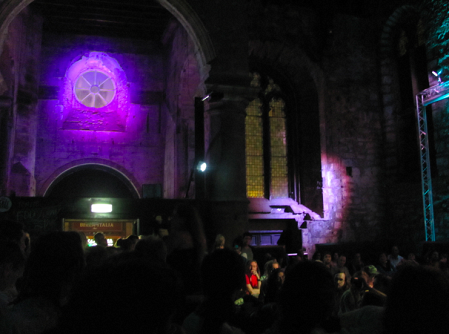
Johnny Bliss, 2012
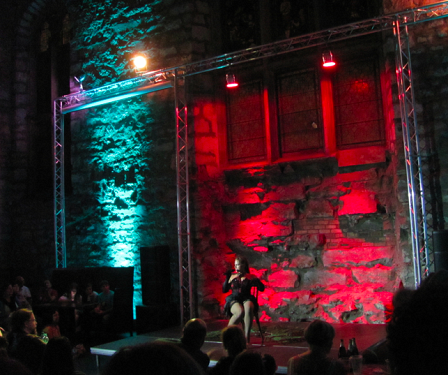
Johnny Bliss, 2012
Unfortunately, the shows did not measure up their surroundings. When I got there, a woman was singing very bland karaoke for well over an hour. The people I was with were eager to see the burlesque show that would follow but we nearly would have left by the time it started.
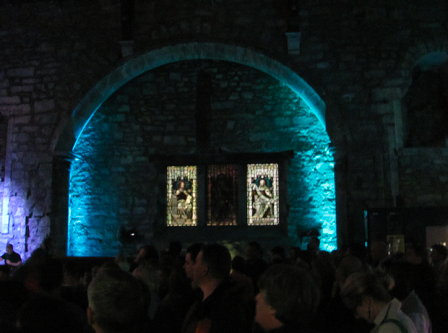
Johnny Bliss, 2012
The burlesque show, when it finally did arrive, was nice - the host of the show and singer had a great style and personality for the role, as did the blonde dancer, who came decked out in some pretty amazing costumes (which she then proceeded to strip out of).
Unfortunately there was only the one singer and the one dancer, which led to long breaks throughout the performance of up to half an hour, just waiting for the costume changes to take place.
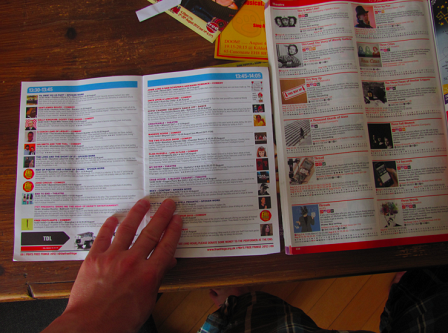
Johnny Bliss, 2012
A more entertaining show, with a much larger ensemble of different performers, was on my last night in town at a smallish venue called the Voodoo Rooms. This was also part of the "Free Fringe" and would be the last proper show of my visit.
The show was called "Itsy's Midnight Kabarett" and was billed as being "bizarre" and "eclectic". Like so many other shows at the Fringe, it was eventually a very mixed bag, but ultimately entertaining and due to the honest (some would say "unprofessional") earnestness of the hosts and stars, an unexpected highlight.
It was strange; the hosts came on stage and made a show of being both drunk and highly self-conscious. They sang but stopped sometimes during the songs to complain of being sweaty and/or depressed.

Johnny Bliss, 2012
There was a magic show - no, two magic shows - one of which was absolutely amazing with the performer producing cards and other objects from out of nowhere - and I literally could see no possible way he was creating these illusions; very professionally done. Unfortunately at the same time, the accompanying classical music CD was skipping constantly. He smiled and laughed about it and made the best of the situation, but it was nevertheless distracting and a real shame. It seemed that nearly every one of the mini-performances suffered from something like this. Amazing talent combined with technical difficulties and alcohol-fueled disorganization.
I'm saying all this, but let me remind you: I think this genuinely was one of the best - certainly most flamboyant - shows that I saw during the festival, especially in the "free" area. There were three burlesque strippers, one of whom was a man in very minimalist drag (ie. make up and a toga); meanwhile, the girls had, again, amazing costumes.
I apologize for not having pictures, but it did not feel appropriate to be taking them, what with all the nudity and the intimacy of the environment. To make up for that, here instead is a picture of a seagull.
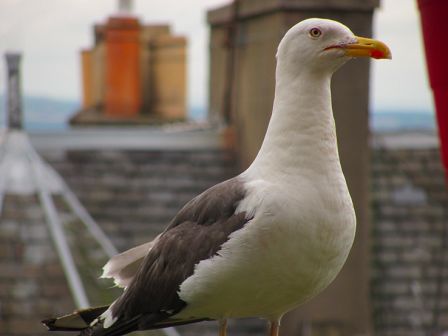
Johnny Bliss, 2012
I saw other shows, but in retrospect they don't all necessarily stand out in my mind as much as the performances I have referenced here. In the end, I have no doubt that I missed the majority of the most amazing shows at the Fringe. My week in Edinburgh was sufficient to scratch the surface of this festival, and little else.
Will I go back? Yes, definitely. And next time I plan to break with tradition and actually organize seeing some shows ahead of time. I would recommend you do the same.


